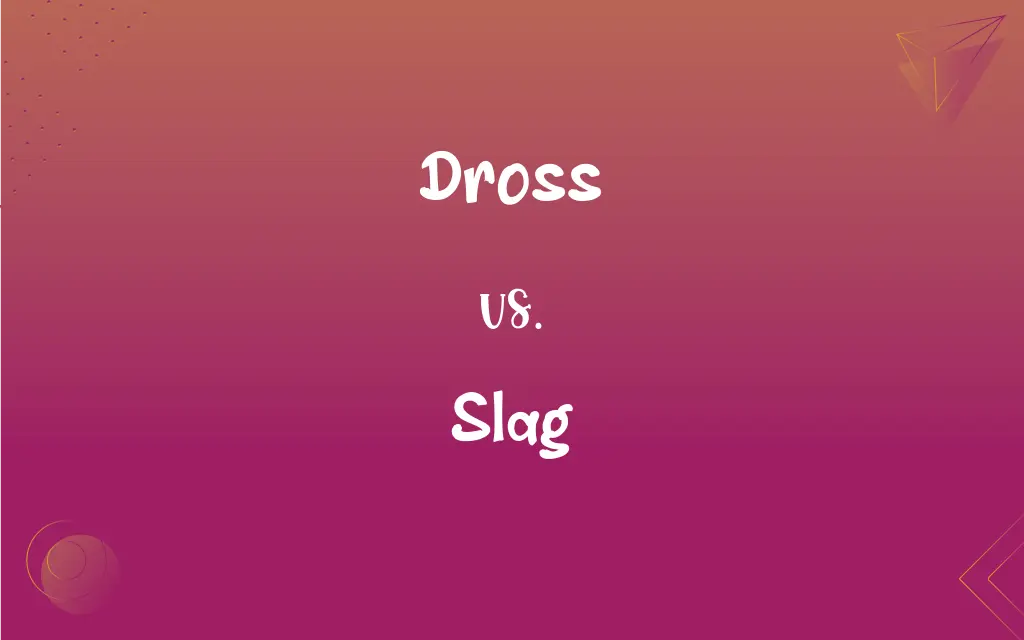Dross vs. Slag: What's the Difference?
By Harlon Moss & Janet White || Updated on May 28, 2024
Dross refers to the impurities removed from metals during smelting, while slag is a byproduct formed from the reaction of flux and impurities in the smelting process.

Key Differences
Dross is primarily associated with the waste material that forms on the surface of molten metal during smelting. It consists of oxidized impurities that are skimmed off to purify the metal. Slag, on the other hand, is a byproduct of the smelting process, resulting from the combination of flux and non-metallic elements. It is typically more voluminous and can be reused in construction materials.
Dross tends to form as a crust on the surface of the molten metal and is usually lighter and more easily removable. It is often recycled to recover any remaining metal content. Slag forms a more solid mass that settles out of the molten metal and can be broken down into smaller pieces for various uses.
In terms of composition, dross mainly contains metal oxides and may include some trapped metal, whereas slag contains silicates, alumina, and other compounds resulting from the reaction with flux. Both dross and slag are considered waste products, but slag has more applications in other industries due to its mineral content.
Dross is typically less environmentally hazardous compared to slag, which can contain potentially harmful elements that require careful handling and disposal. Slag's reuse in construction can mitigate some environmental impact by reducing waste and providing alternative materials.
Comparison Chart
Definition
Impurities removed from molten metal
Byproduct formed from flux and impurities
ADVERTISEMENT
Formation
Forms on the surface of molten metal
Results from reactions in smelting process
Composition
Metal oxides and trapped metal
Silicates, alumina, and other compounds
Removal
Skimmed off easily from surface
Solid mass that settles out
Environmental Impact
Less hazardous
Can contain harmful elements
Dross and Slag Definitions
Dross
Oxidized impurities in metal.
The blacksmith removed the dross to purify the iron.
ADVERTISEMENT
Slag
Waste from the reaction of flux and impurities.
The slag was used in road construction.
Dross
Scum on molten metal.
The dross formed quickly on the surface during smelting.
Slag
Non-metallic residue in smelting.
Slag contains silicates and other compounds.
Dross
Worthless or trivial matter.
His comments were dismissed as dross.
Slag
Solid mass formed during smelting.
The slag was broken down for reuse.
Dross
Unwanted byproduct in metalworking.
They recycled the dross to recover any remaining tin.
Slag
Industrial byproduct with potential reuse.
They processed the slag for cement production.
Dross
Waste or impure matter
Discarded the dross after recycling the wood pulp.
Slag
The vitreous mass left as a residue by the smelting of metallic ore.
Dross
The scum that forms on the surface of molten metal as a result of oxidation.
Slag
See scoria.
Dross
Worthless, commonplace, or trivial matter
"He was wide-awake and his mind worked clearly, purged of all dross" (Vladimir Nabokov).
Slag
To change into or form slag.
Dross
Waste or impure matter.
Slag
Waste material from a mine.
Dross
Residue that forms on the surface of molten metal from oxidation.
Slag
Scum that forms on the surface of molten metal.
Dross
The impurities in metal.
Slag
Impurities formed and separated out when a metal is smelted from ore; vitrified cinders.
Dross
A waste product from working with metal.
Slag
Hard aggregate remaining as a residue from blast furnaces, sometimes used as a surfacing material.
Dross
(figurative) Worthless or trivial matter.
Slag
Scoria associated with a volcano.
Dross
(transitive) To remove dross from.
Slag
A coward.
Dross
The scum or refuse matter which is thrown off, or falls from, metals in smelting the ore, or in the process of melting; recrement.
Slag
A contemptible person, a scumbag.
Dross
Rust of metals.
Slag
A prostitute, or a woman who acts like one; a slut.
Dross
Waste matter; any worthless matter separated from the better part; leavings; dregs; refuse.
All world's glory is but dross unclean.
At the devil's booth are all things sold,Each ounce of dross coats its ounce of gold.
Slag
(transitive) To produce slag.
Dross
Worthless material that should be removed;
There were impurities in the water
Slag
(intransitive) To become slag; to agglomerate when heated below the fusion point.
Dross
The scum formed by oxidation at the surface of molten metals
Slag
(transitive) To reduce to slag.
Dross
Waste material from molten metal.
The dross was skimmed off the surface of the aluminum.
Slag
To talk badly about; to malign or denigrate (someone).
Slag
To spit.
Slag
The dross, or recrement, of a metal; also, vitrified cinders.
Slag
The scoria of a volcano.
Slag
A product of smelting, containing, mostly as silicates, the substances not sought to be produced as matte or metal, and having a lower specific gravity than the latter; - called also, esp. in iron smelting, cinder. The slag of iron blast furnaces is essentially silicate of calcium, magnesium, and aluminium; that of lead and copper smelting furnaces contains iron.
Slag
To form, or form into, a slag; to agglomerate when heated below the fusion point.
Slag
The scum formed by oxidation at the surface of molten metals
Slag
Byproduct of smelting metal.
The steel mill produces a lot of slag.
FAQs
What is dross?
Dross is the impurities removed from the surface of molten metal during smelting.
Can dross be recycled?
Yes, dross can often be recycled to recover any remaining metal content.
What is slag?
Slag is a byproduct formed from the reaction of flux and impurities during the smelting process.
How is slag formed?
Slag forms from the combination of flux and non-metallic elements in the molten metal.
What is the main difference between dross and slag?
Dross is mainly oxidized impurities on the surface, while slag is a solid byproduct from flux reactions.
Is dross harmful?
Dross is generally less harmful compared to slag, but it still requires proper handling.
Is slag hazardous?
Slag can contain harmful elements and needs careful disposal or treatment for reuse.
What does dross contain?
Dross contains metal oxides and possibly some trapped metal.
How is slag handled?
Slag is collected and can be broken down for reuse or disposed of.
How is dross formed?
Dross forms as a crust of oxidized impurities on the surface of molten metal.
Can slag be reused?
Yes, slag can be reused in construction materials, road building, and other applications.
What does slag contain?
Slag contains silicates, alumina, and other compounds from the flux reaction.
How is dross removed?
Dross is skimmed off the surface of the molten metal.
Why is dross important in metallurgy?
Removing dross is crucial for purifying metals and improving quality.
What industries produce dross?
Dross is produced in metalworking and smelting industries.
Is dross considered waste?
Yes, dross is considered a waste product but can be recycled.
Is slag environmentally friendly?
Slag can be environmentally friendly if reused properly, reducing waste.
Why is slag useful in construction?
Slag provides a durable and cost-effective material for various construction applications.
What is the main purpose of flux in smelting?
Flux helps to combine with impurities to form slag, facilitating their removal from the molten metal.
What industries use slag?
Slag is used in construction, cement production, and road building.
About Author
Written by
Harlon MossHarlon is a seasoned quality moderator and accomplished content writer for Difference Wiki. An alumnus of the prestigious University of California, he earned his degree in Computer Science. Leveraging his academic background, Harlon brings a meticulous and informed perspective to his work, ensuring content accuracy and excellence.
Co-written by
Janet WhiteJanet White has been an esteemed writer and blogger for Difference Wiki. Holding a Master's degree in Science and Medical Journalism from the prestigious Boston University, she has consistently demonstrated her expertise and passion for her field. When she's not immersed in her work, Janet relishes her time exercising, delving into a good book, and cherishing moments with friends and family.































































